MGMT 601: Emotional Intelligence Report on Leadership Effectiveness
VerifiedAdded on 2023/01/23
|8
|1900
|46
Report
AI Summary
This report, prepared for an executive meeting, explores the critical role of emotional intelligence (EI) in leadership. It begins by defining EI as the ability to understand and manage one's own emotions and those of others, essential for effective leadership in diverse work environments. The report details the five key factors of EI: self-awareness, self-regulation, self-motivation, empathy, and social skills, explaining how each contributes to leadership effectiveness. Self-awareness allows leaders to understand their strengths and weaknesses, self-regulation enables them to manage their emotions, self-motivation drives them to achieve goals, empathy fosters understanding of others, and social skills facilitate effective communication and relationship building. The report then investigates whether EI can be taught, concluding that it is possible through behavioral changes and training. It outlines methods for developing each EI factor and discusses how to recognize EI in others beyond formal tests, such as observing their curiosity and ability to handle conflict. The report concludes by emphasizing the importance of EI for leaders to manage emotional diversity and achieve organizational objectives.
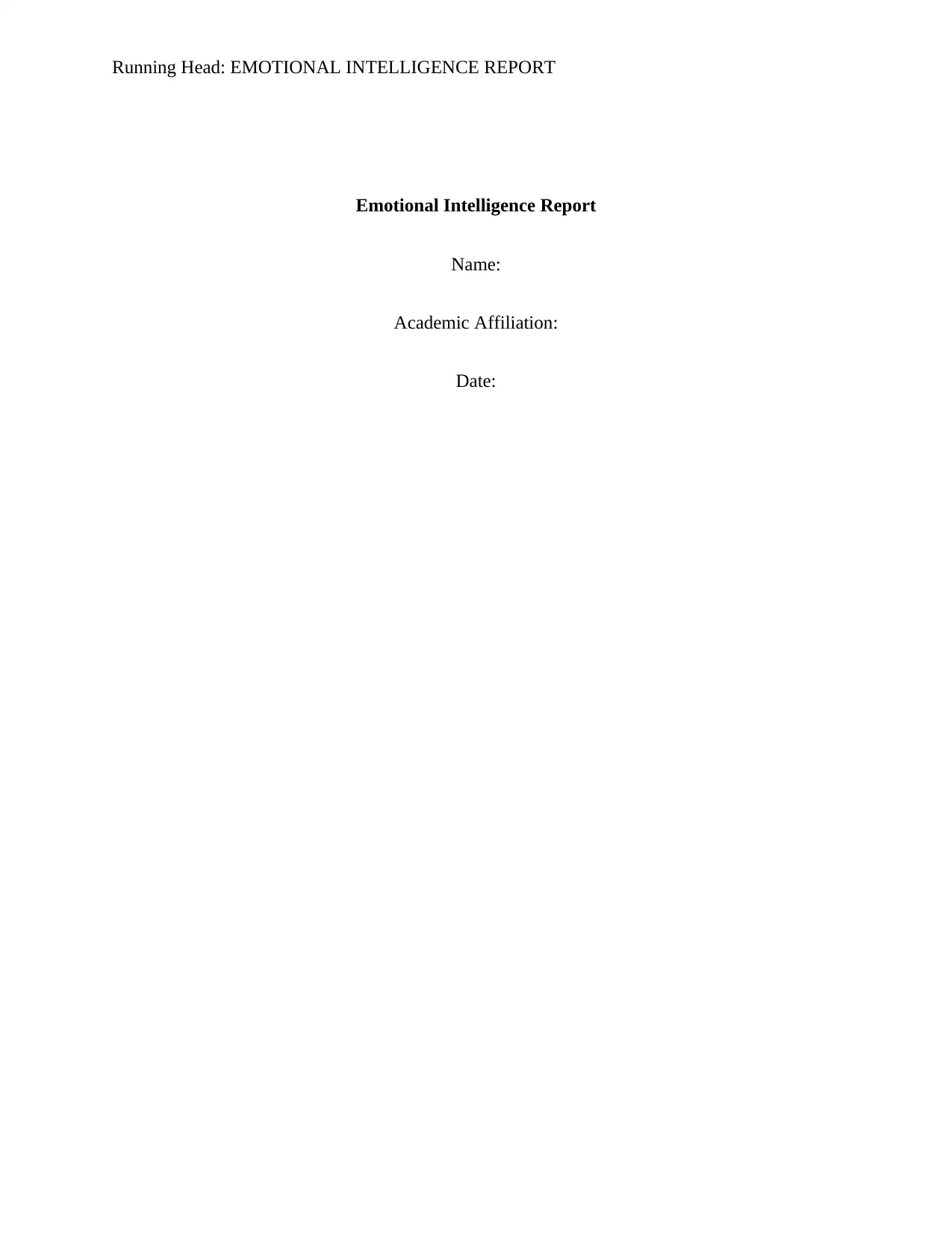
Running Head: EMOTIONAL INTELLIGENCE REPORT
Emotional Intelligence Report
Name:
Academic Affiliation:
Date:
Emotional Intelligence Report
Name:
Academic Affiliation:
Date:
Paraphrase This Document
Need a fresh take? Get an instant paraphrase of this document with our AI Paraphraser
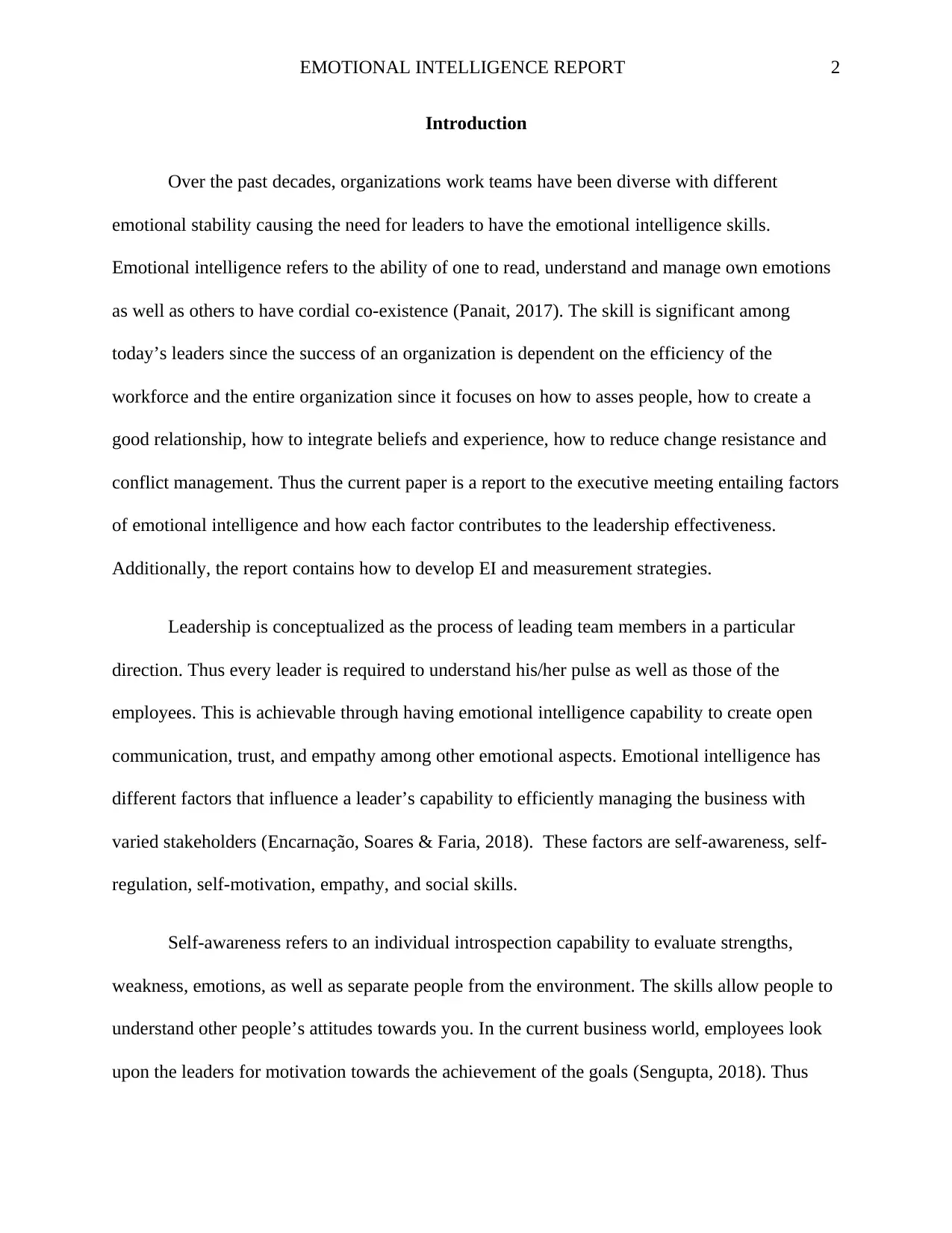
EMOTIONAL INTELLIGENCE REPORT 2
Introduction
Over the past decades, organizations work teams have been diverse with different
emotional stability causing the need for leaders to have the emotional intelligence skills.
Emotional intelligence refers to the ability of one to read, understand and manage own emotions
as well as others to have cordial co-existence (Panait, 2017). The skill is significant among
today’s leaders since the success of an organization is dependent on the efficiency of the
workforce and the entire organization since it focuses on how to asses people, how to create a
good relationship, how to integrate beliefs and experience, how to reduce change resistance and
conflict management. Thus the current paper is a report to the executive meeting entailing factors
of emotional intelligence and how each factor contributes to the leadership effectiveness.
Additionally, the report contains how to develop EI and measurement strategies.
Leadership is conceptualized as the process of leading team members in a particular
direction. Thus every leader is required to understand his/her pulse as well as those of the
employees. This is achievable through having emotional intelligence capability to create open
communication, trust, and empathy among other emotional aspects. Emotional intelligence has
different factors that influence a leader’s capability to efficiently managing the business with
varied stakeholders (Encarnação, Soares & Faria, 2018). These factors are self-awareness, self-
regulation, self-motivation, empathy, and social skills.
Self-awareness refers to an individual introspection capability to evaluate strengths,
weakness, emotions, as well as separate people from the environment. The skills allow people to
understand other people’s attitudes towards you. In the current business world, employees look
upon the leaders for motivation towards the achievement of the goals (Sengupta, 2018). Thus
Introduction
Over the past decades, organizations work teams have been diverse with different
emotional stability causing the need for leaders to have the emotional intelligence skills.
Emotional intelligence refers to the ability of one to read, understand and manage own emotions
as well as others to have cordial co-existence (Panait, 2017). The skill is significant among
today’s leaders since the success of an organization is dependent on the efficiency of the
workforce and the entire organization since it focuses on how to asses people, how to create a
good relationship, how to integrate beliefs and experience, how to reduce change resistance and
conflict management. Thus the current paper is a report to the executive meeting entailing factors
of emotional intelligence and how each factor contributes to the leadership effectiveness.
Additionally, the report contains how to develop EI and measurement strategies.
Leadership is conceptualized as the process of leading team members in a particular
direction. Thus every leader is required to understand his/her pulse as well as those of the
employees. This is achievable through having emotional intelligence capability to create open
communication, trust, and empathy among other emotional aspects. Emotional intelligence has
different factors that influence a leader’s capability to efficiently managing the business with
varied stakeholders (Encarnação, Soares & Faria, 2018). These factors are self-awareness, self-
regulation, self-motivation, empathy, and social skills.
Self-awareness refers to an individual introspection capability to evaluate strengths,
weakness, emotions, as well as separate people from the environment. The skills allow people to
understand other people’s attitudes towards you. In the current business world, employees look
upon the leaders for motivation towards the achievement of the goals (Sengupta, 2018). Thus
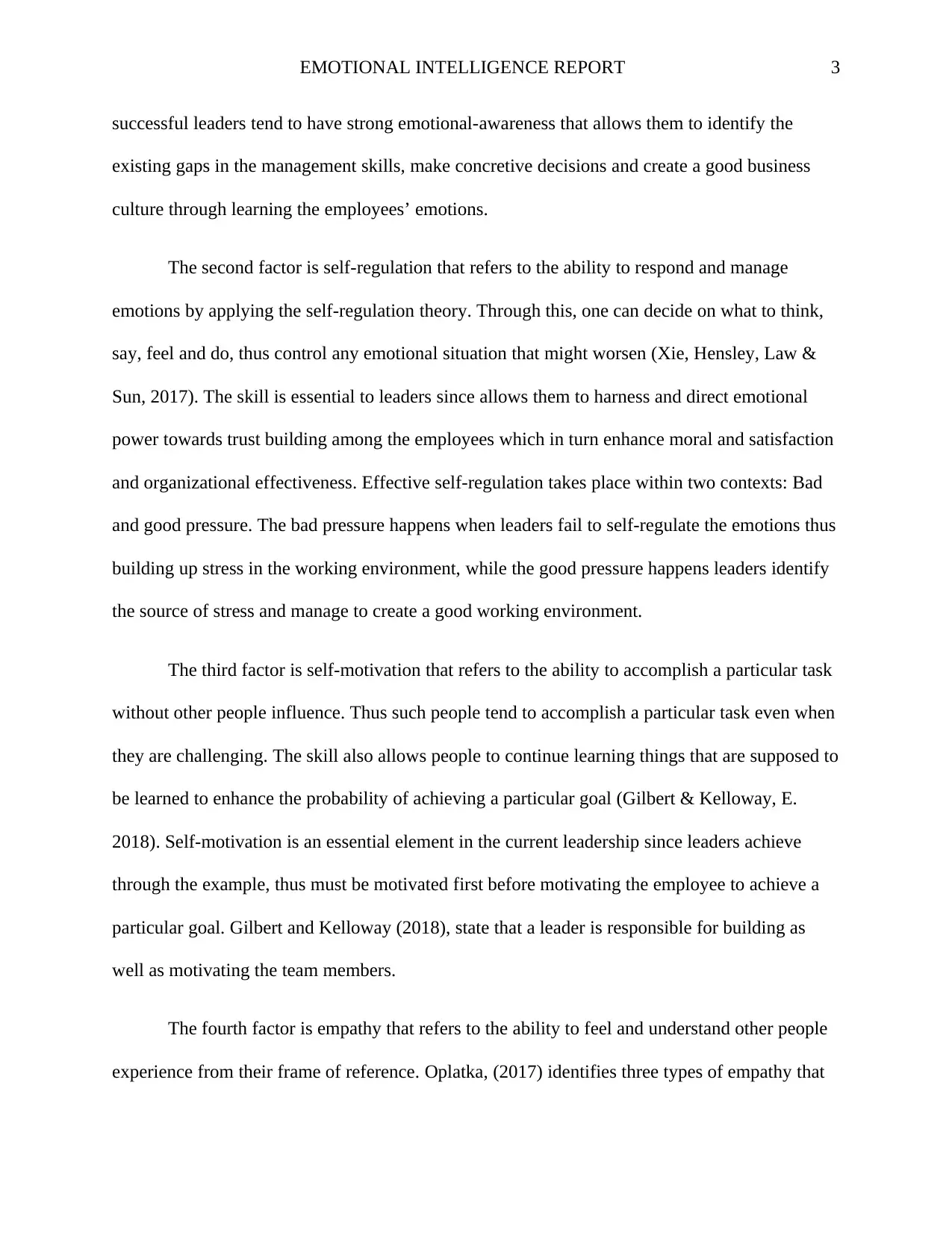
EMOTIONAL INTELLIGENCE REPORT 3
successful leaders tend to have strong emotional-awareness that allows them to identify the
existing gaps in the management skills, make concretive decisions and create a good business
culture through learning the employees’ emotions.
The second factor is self-regulation that refers to the ability to respond and manage
emotions by applying the self-regulation theory. Through this, one can decide on what to think,
say, feel and do, thus control any emotional situation that might worsen (Xie, Hensley, Law &
Sun, 2017). The skill is essential to leaders since allows them to harness and direct emotional
power towards trust building among the employees which in turn enhance moral and satisfaction
and organizational effectiveness. Effective self-regulation takes place within two contexts: Bad
and good pressure. The bad pressure happens when leaders fail to self-regulate the emotions thus
building up stress in the working environment, while the good pressure happens leaders identify
the source of stress and manage to create a good working environment.
The third factor is self-motivation that refers to the ability to accomplish a particular task
without other people influence. Thus such people tend to accomplish a particular task even when
they are challenging. The skill also allows people to continue learning things that are supposed to
be learned to enhance the probability of achieving a particular goal (Gilbert & Kelloway, E.
2018). Self-motivation is an essential element in the current leadership since leaders achieve
through the example, thus must be motivated first before motivating the employee to achieve a
particular goal. Gilbert and Kelloway (2018), state that a leader is responsible for building as
well as motivating the team members.
The fourth factor is empathy that refers to the ability to feel and understand other people
experience from their frame of reference. Oplatka, (2017) identifies three types of empathy that
successful leaders tend to have strong emotional-awareness that allows them to identify the
existing gaps in the management skills, make concretive decisions and create a good business
culture through learning the employees’ emotions.
The second factor is self-regulation that refers to the ability to respond and manage
emotions by applying the self-regulation theory. Through this, one can decide on what to think,
say, feel and do, thus control any emotional situation that might worsen (Xie, Hensley, Law &
Sun, 2017). The skill is essential to leaders since allows them to harness and direct emotional
power towards trust building among the employees which in turn enhance moral and satisfaction
and organizational effectiveness. Effective self-regulation takes place within two contexts: Bad
and good pressure. The bad pressure happens when leaders fail to self-regulate the emotions thus
building up stress in the working environment, while the good pressure happens leaders identify
the source of stress and manage to create a good working environment.
The third factor is self-motivation that refers to the ability to accomplish a particular task
without other people influence. Thus such people tend to accomplish a particular task even when
they are challenging. The skill also allows people to continue learning things that are supposed to
be learned to enhance the probability of achieving a particular goal (Gilbert & Kelloway, E.
2018). Self-motivation is an essential element in the current leadership since leaders achieve
through the example, thus must be motivated first before motivating the employee to achieve a
particular goal. Gilbert and Kelloway (2018), state that a leader is responsible for building as
well as motivating the team members.
The fourth factor is empathy that refers to the ability to feel and understand other people
experience from their frame of reference. Oplatka, (2017) identifies three types of empathy that
⊘ This is a preview!⊘
Do you want full access?
Subscribe today to unlock all pages.

Trusted by 1+ million students worldwide
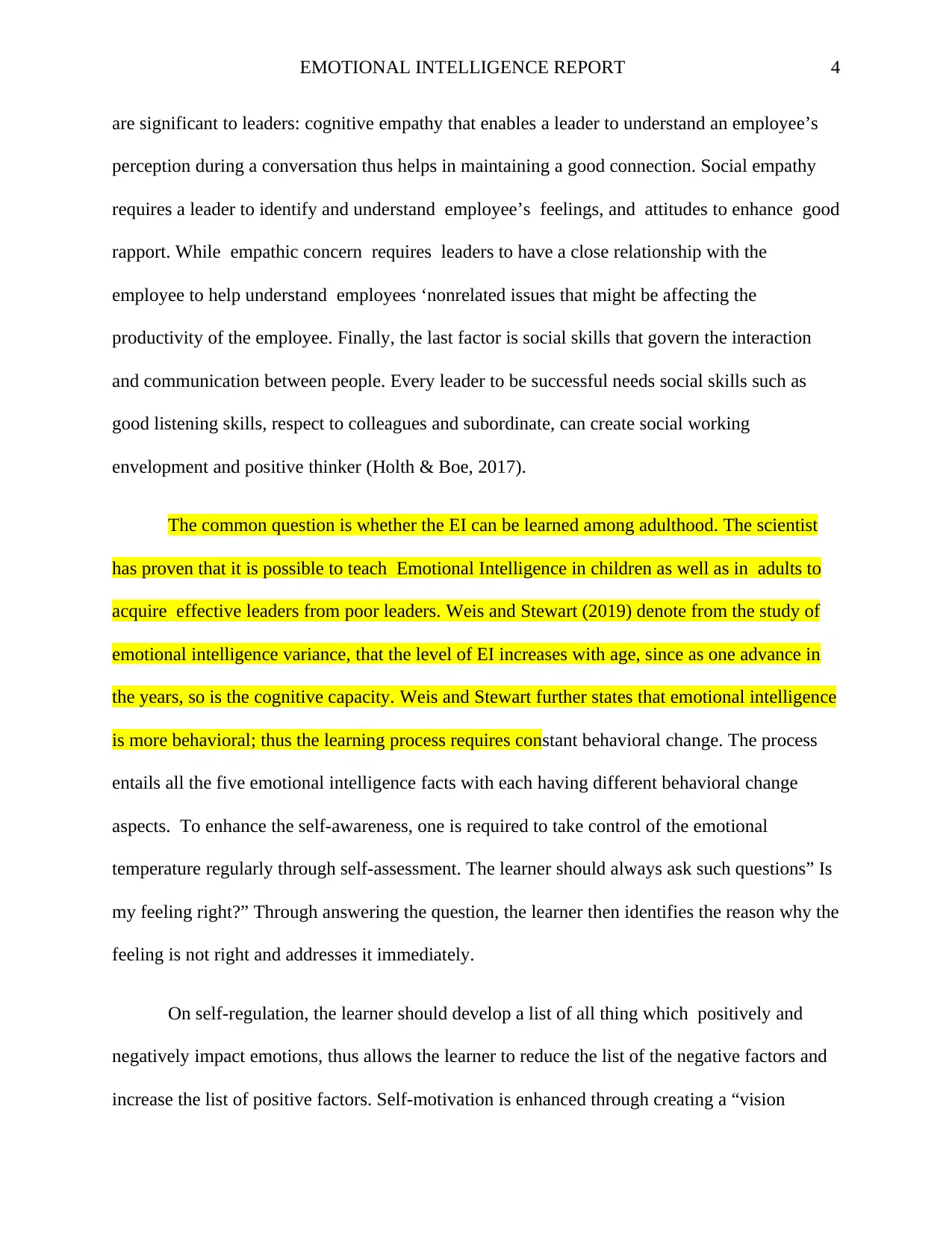
EMOTIONAL INTELLIGENCE REPORT 4
are significant to leaders: cognitive empathy that enables a leader to understand an employee’s
perception during a conversation thus helps in maintaining a good connection. Social empathy
requires a leader to identify and understand employee’s feelings, and attitudes to enhance good
rapport. While empathic concern requires leaders to have a close relationship with the
employee to help understand employees ‘nonrelated issues that might be affecting the
productivity of the employee. Finally, the last factor is social skills that govern the interaction
and communication between people. Every leader to be successful needs social skills such as
good listening skills, respect to colleagues and subordinate, can create social working
envelopment and positive thinker (Holth & Boe, 2017).
The common question is whether the EI can be learned among adulthood. The scientist
has proven that it is possible to teach Emotional Intelligence in children as well as in adults to
acquire effective leaders from poor leaders. Weis and Stewart (2019) denote from the study of
emotional intelligence variance, that the level of EI increases with age, since as one advance in
the years, so is the cognitive capacity. Weis and Stewart further states that emotional intelligence
is more behavioral; thus the learning process requires constant behavioral change. The process
entails all the five emotional intelligence facts with each having different behavioral change
aspects. To enhance the self-awareness, one is required to take control of the emotional
temperature regularly through self-assessment. The learner should always ask such questions” Is
my feeling right?” Through answering the question, the learner then identifies the reason why the
feeling is not right and addresses it immediately.
On self-regulation, the learner should develop a list of all thing which positively and
negatively impact emotions, thus allows the learner to reduce the list of the negative factors and
increase the list of positive factors. Self-motivation is enhanced through creating a “vision
are significant to leaders: cognitive empathy that enables a leader to understand an employee’s
perception during a conversation thus helps in maintaining a good connection. Social empathy
requires a leader to identify and understand employee’s feelings, and attitudes to enhance good
rapport. While empathic concern requires leaders to have a close relationship with the
employee to help understand employees ‘nonrelated issues that might be affecting the
productivity of the employee. Finally, the last factor is social skills that govern the interaction
and communication between people. Every leader to be successful needs social skills such as
good listening skills, respect to colleagues and subordinate, can create social working
envelopment and positive thinker (Holth & Boe, 2017).
The common question is whether the EI can be learned among adulthood. The scientist
has proven that it is possible to teach Emotional Intelligence in children as well as in adults to
acquire effective leaders from poor leaders. Weis and Stewart (2019) denote from the study of
emotional intelligence variance, that the level of EI increases with age, since as one advance in
the years, so is the cognitive capacity. Weis and Stewart further states that emotional intelligence
is more behavioral; thus the learning process requires constant behavioral change. The process
entails all the five emotional intelligence facts with each having different behavioral change
aspects. To enhance the self-awareness, one is required to take control of the emotional
temperature regularly through self-assessment. The learner should always ask such questions” Is
my feeling right?” Through answering the question, the learner then identifies the reason why the
feeling is not right and addresses it immediately.
On self-regulation, the learner should develop a list of all thing which positively and
negatively impact emotions, thus allows the learner to reduce the list of the negative factors and
increase the list of positive factors. Self-motivation is enhanced through creating a “vision
Paraphrase This Document
Need a fresh take? Get an instant paraphrase of this document with our AI Paraphraser
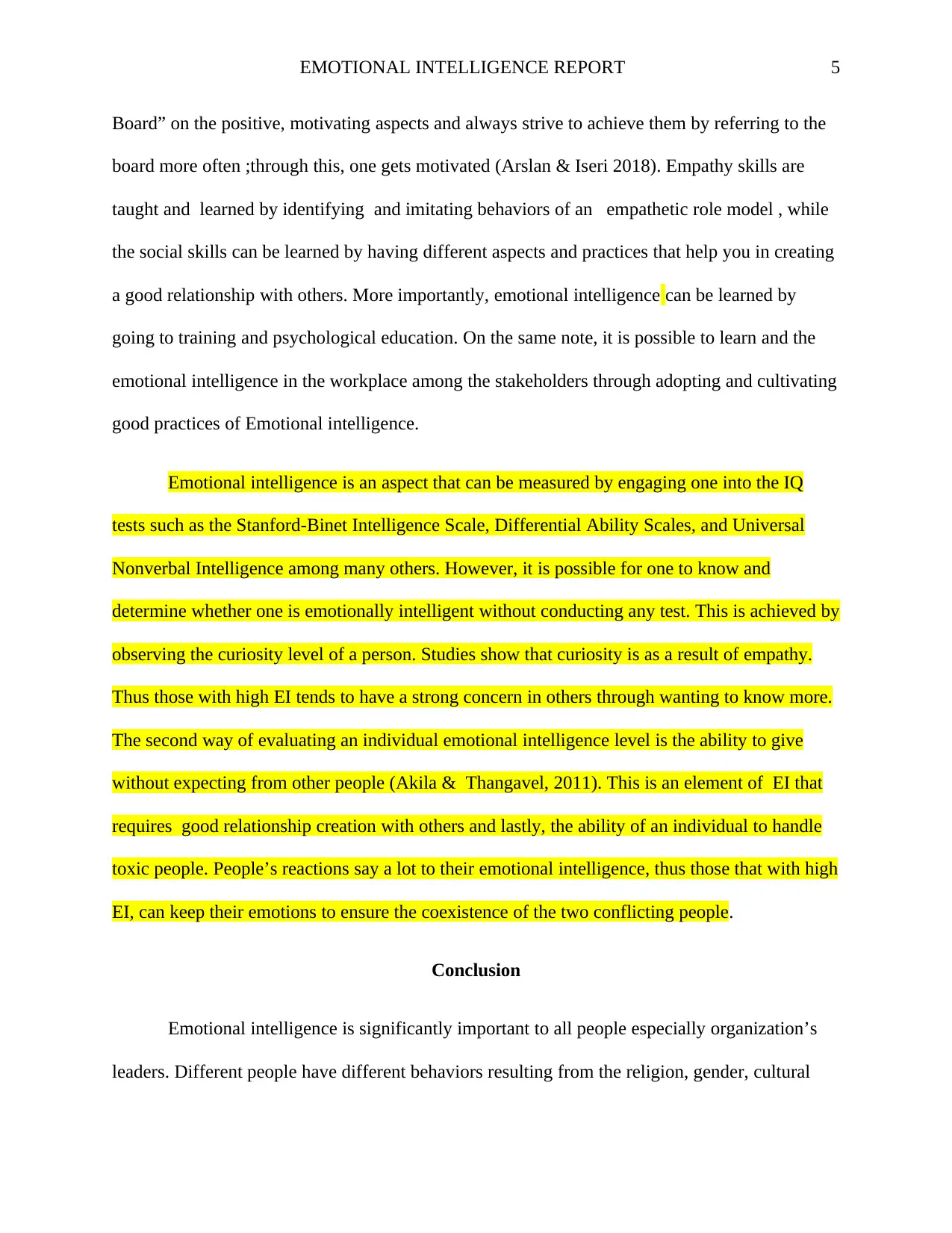
EMOTIONAL INTELLIGENCE REPORT 5
Board” on the positive, motivating aspects and always strive to achieve them by referring to the
board more often ;through this, one gets motivated (Arslan & Iseri 2018). Empathy skills are
taught and learned by identifying and imitating behaviors of an empathetic role model , while
the social skills can be learned by having different aspects and practices that help you in creating
a good relationship with others. More importantly, emotional intelligence can be learned by
going to training and psychological education. On the same note, it is possible to learn and the
emotional intelligence in the workplace among the stakeholders through adopting and cultivating
good practices of Emotional intelligence.
Emotional intelligence is an aspect that can be measured by engaging one into the IQ
tests such as the Stanford-Binet Intelligence Scale, Differential Ability Scales, and Universal
Nonverbal Intelligence among many others. However, it is possible for one to know and
determine whether one is emotionally intelligent without conducting any test. This is achieved by
observing the curiosity level of a person. Studies show that curiosity is as a result of empathy.
Thus those with high EI tends to have a strong concern in others through wanting to know more.
The second way of evaluating an individual emotional intelligence level is the ability to give
without expecting from other people (Akila & Thangavel, 2011). This is an element of EI that
requires good relationship creation with others and lastly, the ability of an individual to handle
toxic people. People’s reactions say a lot to their emotional intelligence, thus those that with high
EI, can keep their emotions to ensure the coexistence of the two conflicting people.
Conclusion
Emotional intelligence is significantly important to all people especially organization’s
leaders. Different people have different behaviors resulting from the religion, gender, cultural
Board” on the positive, motivating aspects and always strive to achieve them by referring to the
board more often ;through this, one gets motivated (Arslan & Iseri 2018). Empathy skills are
taught and learned by identifying and imitating behaviors of an empathetic role model , while
the social skills can be learned by having different aspects and practices that help you in creating
a good relationship with others. More importantly, emotional intelligence can be learned by
going to training and psychological education. On the same note, it is possible to learn and the
emotional intelligence in the workplace among the stakeholders through adopting and cultivating
good practices of Emotional intelligence.
Emotional intelligence is an aspect that can be measured by engaging one into the IQ
tests such as the Stanford-Binet Intelligence Scale, Differential Ability Scales, and Universal
Nonverbal Intelligence among many others. However, it is possible for one to know and
determine whether one is emotionally intelligent without conducting any test. This is achieved by
observing the curiosity level of a person. Studies show that curiosity is as a result of empathy.
Thus those with high EI tends to have a strong concern in others through wanting to know more.
The second way of evaluating an individual emotional intelligence level is the ability to give
without expecting from other people (Akila & Thangavel, 2011). This is an element of EI that
requires good relationship creation with others and lastly, the ability of an individual to handle
toxic people. People’s reactions say a lot to their emotional intelligence, thus those that with high
EI, can keep their emotions to ensure the coexistence of the two conflicting people.
Conclusion
Emotional intelligence is significantly important to all people especially organization’s
leaders. Different people have different behaviors resulting from the religion, gender, cultural
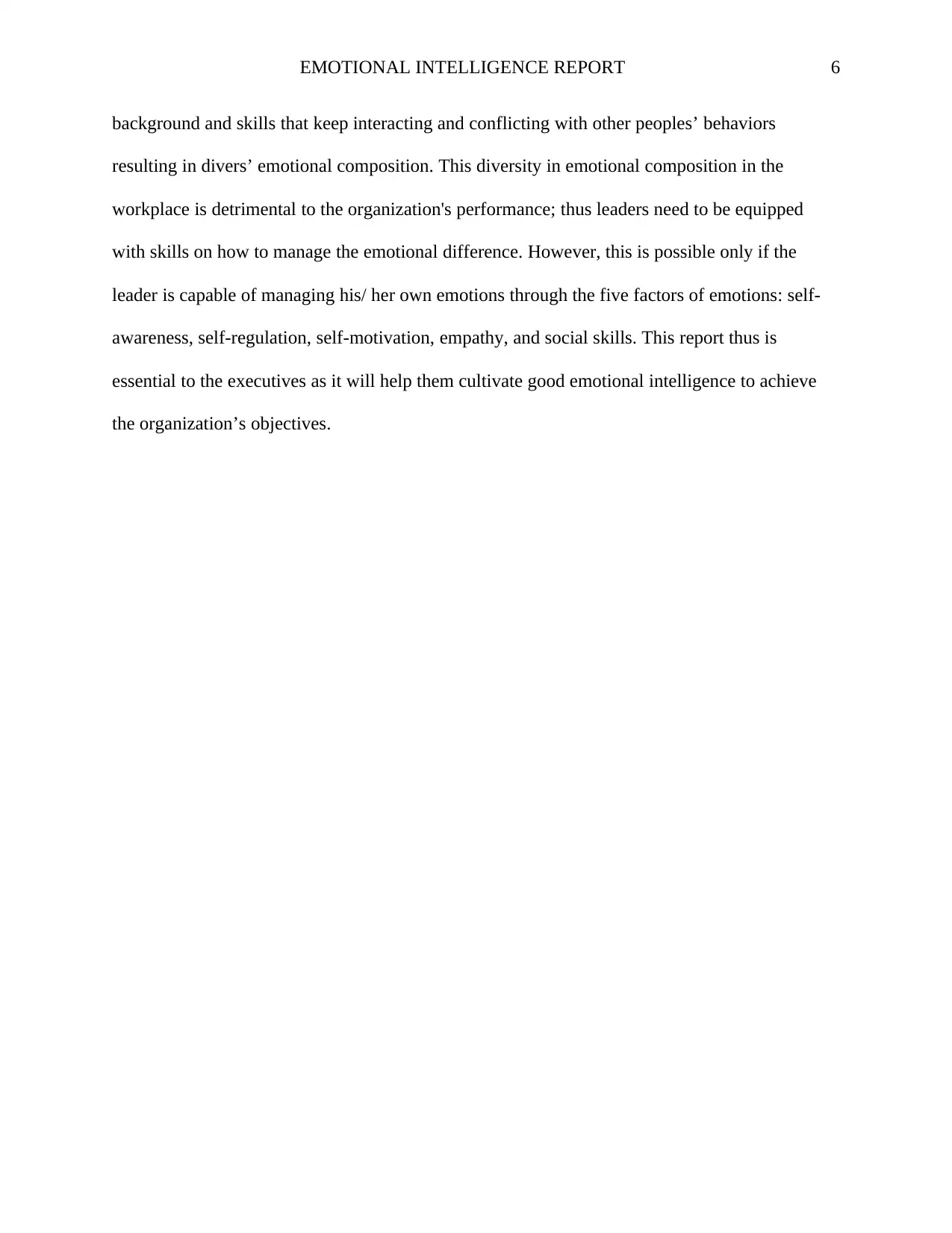
EMOTIONAL INTELLIGENCE REPORT 6
background and skills that keep interacting and conflicting with other peoples’ behaviors
resulting in divers’ emotional composition. This diversity in emotional composition in the
workplace is detrimental to the organization's performance; thus leaders need to be equipped
with skills on how to manage the emotional difference. However, this is possible only if the
leader is capable of managing his/ her own emotions through the five factors of emotions: self-
awareness, self-regulation, self-motivation, empathy, and social skills. This report thus is
essential to the executives as it will help them cultivate good emotional intelligence to achieve
the organization’s objectives.
background and skills that keep interacting and conflicting with other peoples’ behaviors
resulting in divers’ emotional composition. This diversity in emotional composition in the
workplace is detrimental to the organization's performance; thus leaders need to be equipped
with skills on how to manage the emotional difference. However, this is possible only if the
leader is capable of managing his/ her own emotions through the five factors of emotions: self-
awareness, self-regulation, self-motivation, empathy, and social skills. This report thus is
essential to the executives as it will help them cultivate good emotional intelligence to achieve
the organization’s objectives.
⊘ This is a preview!⊘
Do you want full access?
Subscribe today to unlock all pages.

Trusted by 1+ million students worldwide
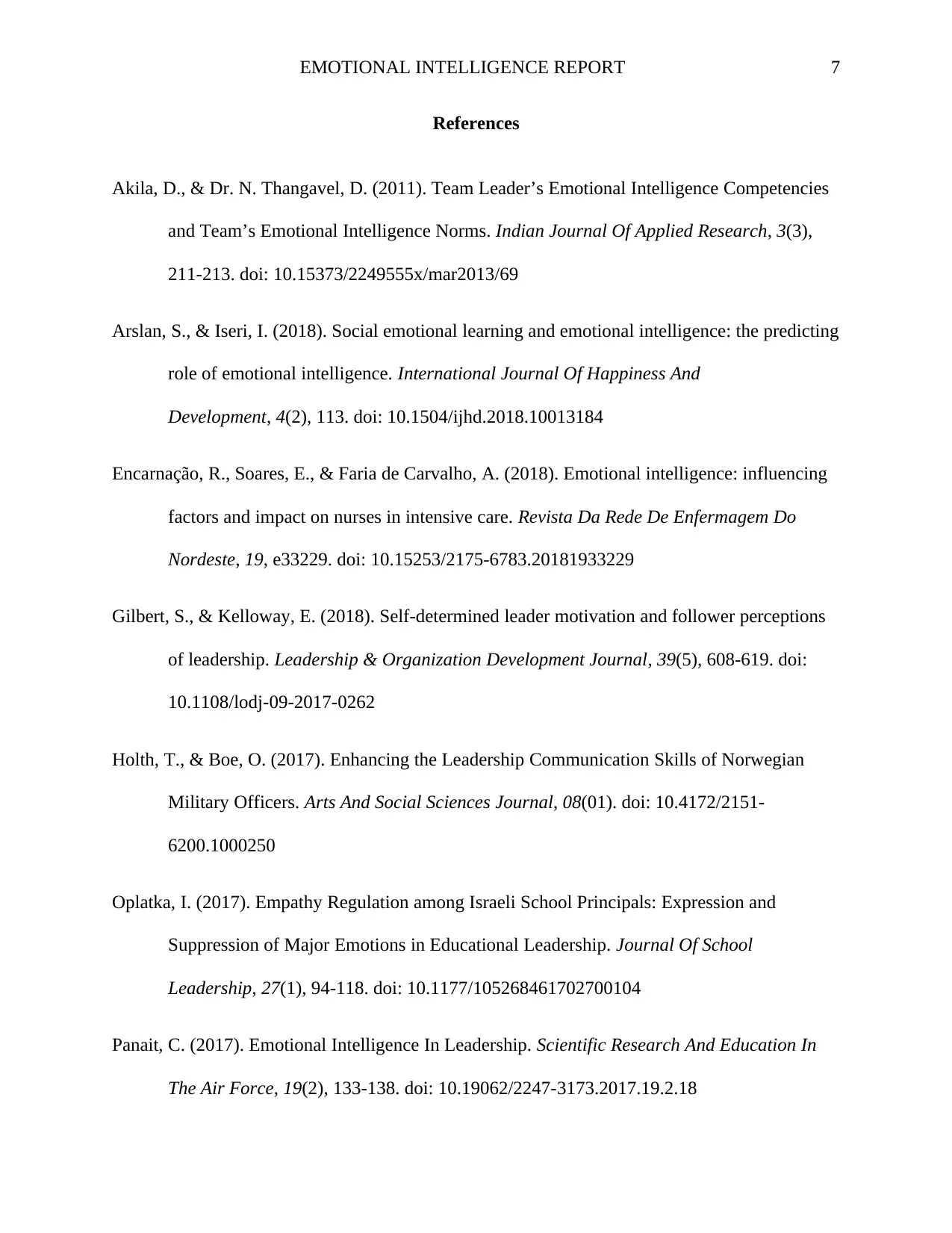
EMOTIONAL INTELLIGENCE REPORT 7
References
Akila, D., & Dr. N. Thangavel, D. (2011). Team Leader’s Emotional Intelligence Competencies
and Team’s Emotional Intelligence Norms. Indian Journal Of Applied Research, 3(3),
211-213. doi: 10.15373/2249555x/mar2013/69
Arslan, S., & Iseri, I. (2018). Social emotional learning and emotional intelligence: the predicting
role of emotional intelligence. International Journal Of Happiness And
Development, 4(2), 113. doi: 10.1504/ijhd.2018.10013184
Encarnação, R., Soares, E., & Faria de Carvalho, A. (2018). Emotional intelligence: influencing
factors and impact on nurses in intensive care. Revista Da Rede De Enfermagem Do
Nordeste, 19, e33229. doi: 10.15253/2175-6783.20181933229
Gilbert, S., & Kelloway, E. (2018). Self-determined leader motivation and follower perceptions
of leadership. Leadership & Organization Development Journal, 39(5), 608-619. doi:
10.1108/lodj-09-2017-0262
Holth, T., & Boe, O. (2017). Enhancing the Leadership Communication Skills of Norwegian
Military Officers. Arts And Social Sciences Journal, 08(01). doi: 10.4172/2151-
6200.1000250
Oplatka, I. (2017). Empathy Regulation among Israeli School Principals: Expression and
Suppression of Major Emotions in Educational Leadership. Journal Of School
Leadership, 27(1), 94-118. doi: 10.1177/105268461702700104
Panait, C. (2017). Emotional Intelligence In Leadership. Scientific Research And Education In
The Air Force, 19(2), 133-138. doi: 10.19062/2247-3173.2017.19.2.18
References
Akila, D., & Dr. N. Thangavel, D. (2011). Team Leader’s Emotional Intelligence Competencies
and Team’s Emotional Intelligence Norms. Indian Journal Of Applied Research, 3(3),
211-213. doi: 10.15373/2249555x/mar2013/69
Arslan, S., & Iseri, I. (2018). Social emotional learning and emotional intelligence: the predicting
role of emotional intelligence. International Journal Of Happiness And
Development, 4(2), 113. doi: 10.1504/ijhd.2018.10013184
Encarnação, R., Soares, E., & Faria de Carvalho, A. (2018). Emotional intelligence: influencing
factors and impact on nurses in intensive care. Revista Da Rede De Enfermagem Do
Nordeste, 19, e33229. doi: 10.15253/2175-6783.20181933229
Gilbert, S., & Kelloway, E. (2018). Self-determined leader motivation and follower perceptions
of leadership. Leadership & Organization Development Journal, 39(5), 608-619. doi:
10.1108/lodj-09-2017-0262
Holth, T., & Boe, O. (2017). Enhancing the Leadership Communication Skills of Norwegian
Military Officers. Arts And Social Sciences Journal, 08(01). doi: 10.4172/2151-
6200.1000250
Oplatka, I. (2017). Empathy Regulation among Israeli School Principals: Expression and
Suppression of Major Emotions in Educational Leadership. Journal Of School
Leadership, 27(1), 94-118. doi: 10.1177/105268461702700104
Panait, C. (2017). Emotional Intelligence In Leadership. Scientific Research And Education In
The Air Force, 19(2), 133-138. doi: 10.19062/2247-3173.2017.19.2.18
Paraphrase This Document
Need a fresh take? Get an instant paraphrase of this document with our AI Paraphraser
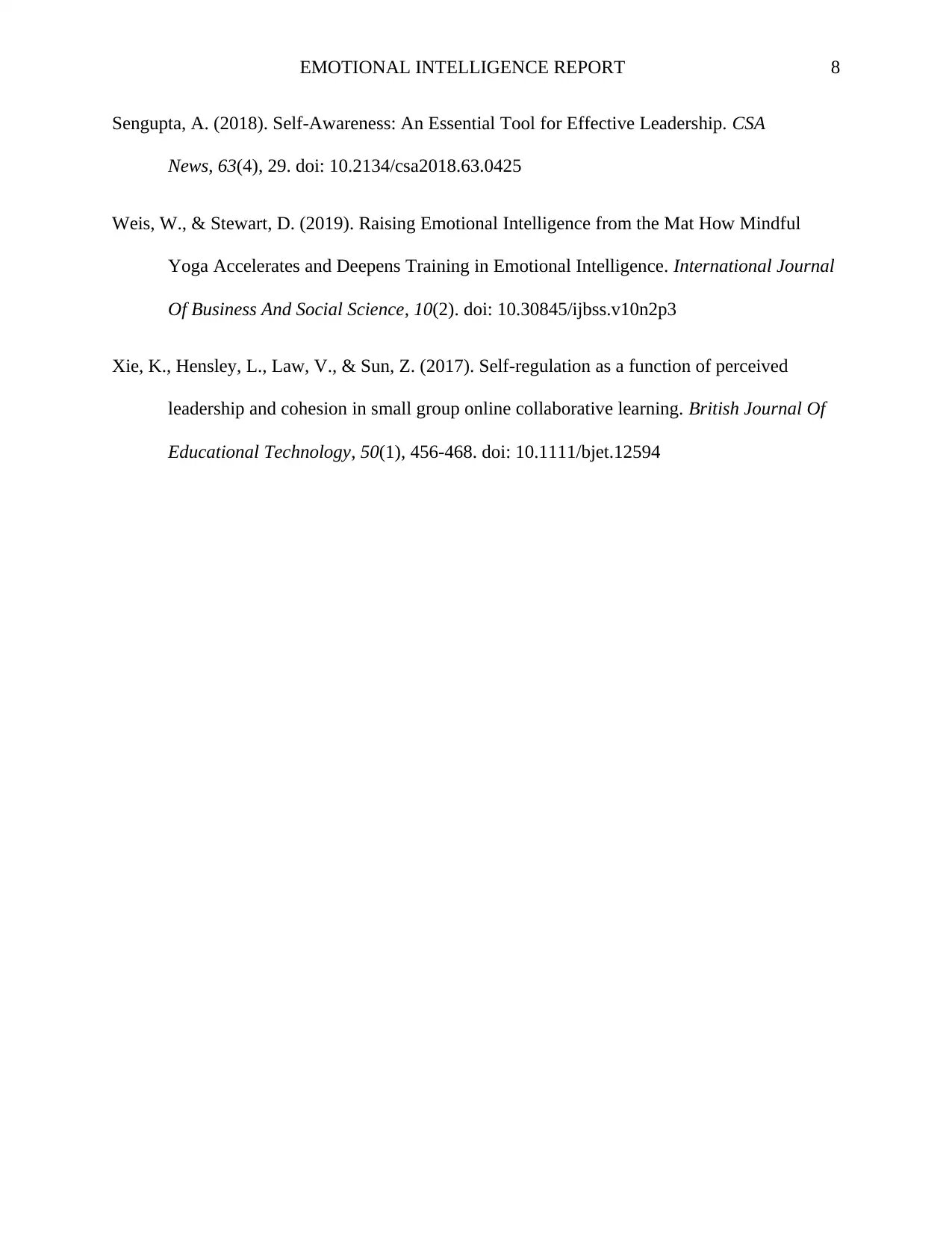
EMOTIONAL INTELLIGENCE REPORT 8
Sengupta, A. (2018). Self-Awareness: An Essential Tool for Effective Leadership. CSA
News, 63(4), 29. doi: 10.2134/csa2018.63.0425
Weis, W., & Stewart, D. (2019). Raising Emotional Intelligence from the Mat How Mindful
Yoga Accelerates and Deepens Training in Emotional Intelligence. International Journal
Of Business And Social Science, 10(2). doi: 10.30845/ijbss.v10n2p3
Xie, K., Hensley, L., Law, V., & Sun, Z. (2017). Self-regulation as a function of perceived
leadership and cohesion in small group online collaborative learning. British Journal Of
Educational Technology, 50(1), 456-468. doi: 10.1111/bjet.12594
Sengupta, A. (2018). Self-Awareness: An Essential Tool for Effective Leadership. CSA
News, 63(4), 29. doi: 10.2134/csa2018.63.0425
Weis, W., & Stewart, D. (2019). Raising Emotional Intelligence from the Mat How Mindful
Yoga Accelerates and Deepens Training in Emotional Intelligence. International Journal
Of Business And Social Science, 10(2). doi: 10.30845/ijbss.v10n2p3
Xie, K., Hensley, L., Law, V., & Sun, Z. (2017). Self-regulation as a function of perceived
leadership and cohesion in small group online collaborative learning. British Journal Of
Educational Technology, 50(1), 456-468. doi: 10.1111/bjet.12594
1 out of 8
Related Documents
Your All-in-One AI-Powered Toolkit for Academic Success.
+13062052269
info@desklib.com
Available 24*7 on WhatsApp / Email
![[object Object]](/_next/static/media/star-bottom.7253800d.svg)
Unlock your academic potential
Copyright © 2020–2025 A2Z Services. All Rights Reserved. Developed and managed by ZUCOL.




